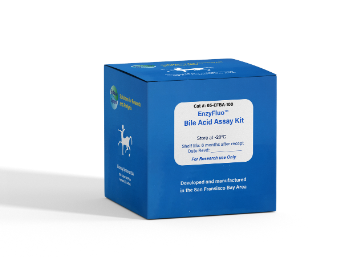DESCRIPTION
Twelve different types of bile acids are typically found in mammals, among them two primary types are cholic acid and chenodeoxycholic acid. These can be dehydroxylated into secondary bile acids. Finally, these four can be conjugated to either taurine or glycine creating 8 different conjugated bile acids.
Bile acid levels in feces, blood, urine, and bile can be used as markers for various diseases such as hyperlipidemia, cholestasis, gall stones, colon cancer, etc. Bile acids also exist in a sulfate salt form known as bile acid-sulfates. Sulfation of bile acids increases their solubility and decreases intestinal absorption, thereby enhancing fecal and urinary excretion. This assay does not measure bile acid-sulfates, and measures only the twelve non-sulfated bile acids.
BioAssay Systems’ Bile Acid Assay Kit provides a convenient fluorimetric means to measure total bile acids in biological samples. In the assay, 3αhydroxysteroid dehydrogenase reacts with all twelve bile acids, converting NAD to NADH, which reduces a probe to a highly fluorescent product. The resulting fluorescence intensity (λexc/em = 530/585 nm) is linear to the bile acid concentration in the sample.
KEY FEATURES
Safe. Non-radioactive assay.
Sensitive and accurate. Linear detection range of 1 - 150 µM bile acids.
Convenient and high-throughput. Homogeneous "mix-incubate-measure" type assay. No wash and reagent transfer steps are involved. Can be readily automated on HTS liquid handling systems for processing thousands of samples per day.
APPLICATIONS
Determination of bile acids in serum, urine and other biological samples.
KIT CONTENTS
Assay Buffer: 10 mL Enzyme A: 120 µL
NAD Solution: 1 mL Enzyme B: 120 µL
Probe: 750 µL Standard: 120 µL
Storage conditions: The kit is shipped on ice. Store all reagents at -20°C. Shelf life of 6 months after receipt.
Precautions: reagents are for research use only. Normal precautions for laboratory reagents should be exercised while using the reagents. Please refer to Material Safety Data Sheet for detailed information.
ASSAY PROCEDURE
Use black flat-bottom plates. Prior to assay, bring all reagents to room temperature. Briefly centrifuge enzyme tubes, keep on ice during assay. Urine samples can be stored at room temperature for 1-2 days, 4°C for 6 days, and at -20°C for 2 weeks. Serum samples can be stored at -20°C for 3 weeks. 3 wells will be needed per sample: Sample, Internal Standard, and Sample Blank.
1. Internal Standard. Prepare 250 µL 80 µM sodium cholate by mixing 20 µL of standard and 230 µL of dH2O.
2. Transfer 20 µL of sample to each of the three wells.
3. Add 5 µL dH2O to Sample and Sample Blank wells, and 5 µL Internal Standard to the Internal Standard well.
4. Working Reagent. For Internal Standard and Sample wells, prepare Working Reagent for each well by mixing 75 µL Assay Buffer, 8 µL NAD, 4 µL Probe, 1 µL Enzyme A and 1 µL Enzyme B. For the Sample Blank wells, prepare Blank Reagent for each well by mixing 75 µL Assay Buffer, 8 µL NAD, 4 µL Probe and 1 µL Enzyme B (i.e. NO Enzyme A). Add 80 µL Working Reagent to Internal Standard and Sample wells, and 80 µL Blank Reagent to the Sample Blank wells.
5. Tap plate to mix. Incubate for 20 min in the dark. Read fluorescence intensity at λexc/em = 530/585 nm.
CALCULATION
Bile acid concentration of a Sample is calculated as
where FSAMPLE, FSTANDARD, and FBLANK are the fluorescence intensity values of the Sample, Internal Standard, and Sample Blank wells, respectively. 20 µM is the effective concentration of the Internal Standard (Internal Standard volume is ¼ the volume of the Sample). n is the dilution factor. Note: if the Sample bile acid concentration is higher than 150 µM, dilute sample in water and repeat the assay. Multiply result by the dilution factor.
MATERIALS REQUIRED, BUT NOT PROVIDED
Pipetting devices, centrifuge tubes, black flat bottom 96-well plates (e.g. Greiner Bio-One, cat# 655900) and fluorescent plate reader capable of reading λexc/em = 530/585 nm.
Note: The graph above is only an example to illustrate the necessity of an internal standard and is not meant as a reference. There can be large variability in background and recovery between samples. The raw values also depend on arbitrary units that your fluorescence plate reader uses.
PUBLICATIONS
1. Sano, M., et al (2020). Increase in the lipopolysaccharide activity and accumulation of gram-negative bacteria in the stomach with low acidity. Clinical and Translational Gastroenterology, 11(7).
2. Igarashi, Muneki, et al (2017). Alteration in the gastric microbiota and its restoration by probiotics in patients with functional dyspepsia. BMJ open gastroenterology 4.1: e000144.
3. Ommati, M. M., et al (2020) Oral administration of thiol-reducing agents
mitigates gut barrier disintegrity and bacterial lipopolysaccharide
translocation in a rat model of biliary obstruction. Current Research in
Pharmacology and Drug Discovery, 1, 10-18.
